What Hi-Fi? Verdict
This exciting and enjoyable laser projector is just the ticket for big, bold movie nights
Pros
- +
Strong HDR feel
- +
Good black depth
- +
Excellent SDR results
Cons
- -
Some colour imbalance
- -
Could be more subtle
Why you can trust What Hi-Fi?
The Optoma UHZ65LV is the latest in a wave of 4K laser projectors set to cause some excitement in the home entertainment space. There are many advantages of laser over its lamp-based cousin with the only real drawback being the extra cost. However, that price is coming down, and quickly.
Back in 2018, we reviewed the Optoma UHZ65 at £5000. This souped-up LV model has more or less the same chassis and lens, but increases the brightness and contrast, and comes in at a much lower price of £3500 ($5999). That difference in cost is crucial – these are both non-native 4K HDR projectors, and with step-up native 4K machines starting at around £5000, the older Optoma was priced out of contention. The LV’s lower price tag means it doesn’t suffer the same problem.
It’s still about a third more than you’d expect to spend on a similar lamp-based projector, but the significant perks could justify that premium. Laser projectors are quicker to start up and shut down, for instance. They’re also often brighter, don’t need to warm up to reach top performance and maintenance is easier because they have a far longer lamp life.
Optoma quotes up to 30,000 hours of life, which is over six times longer than the Award-winning lamp-based projector at this price, the Epson EH-TW9400. Over that same 30,000 hours, you’d need to spend around £900 on replacement bulbs, although if you used a projector for five hours a day every day, it would take over 16 years to get that far, by which time any self-respecting AV addict would have likely upgraded.
Build
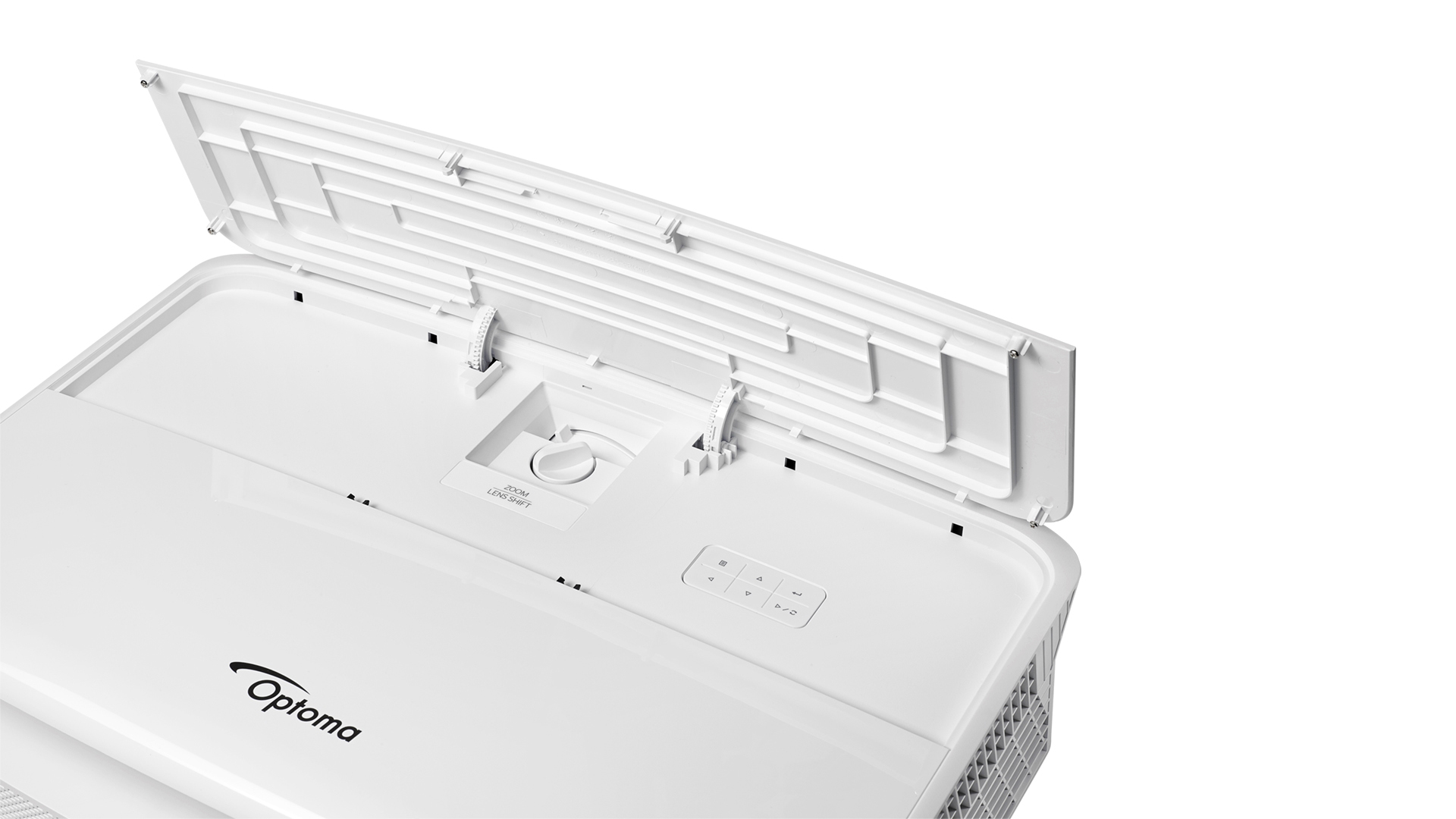
In terms of physical design, the Optoma UHZ65LV is pretty much the same as the original UHZ65. Its physical profile is in line with the rest of the mid-range pixel-shifting projector community.
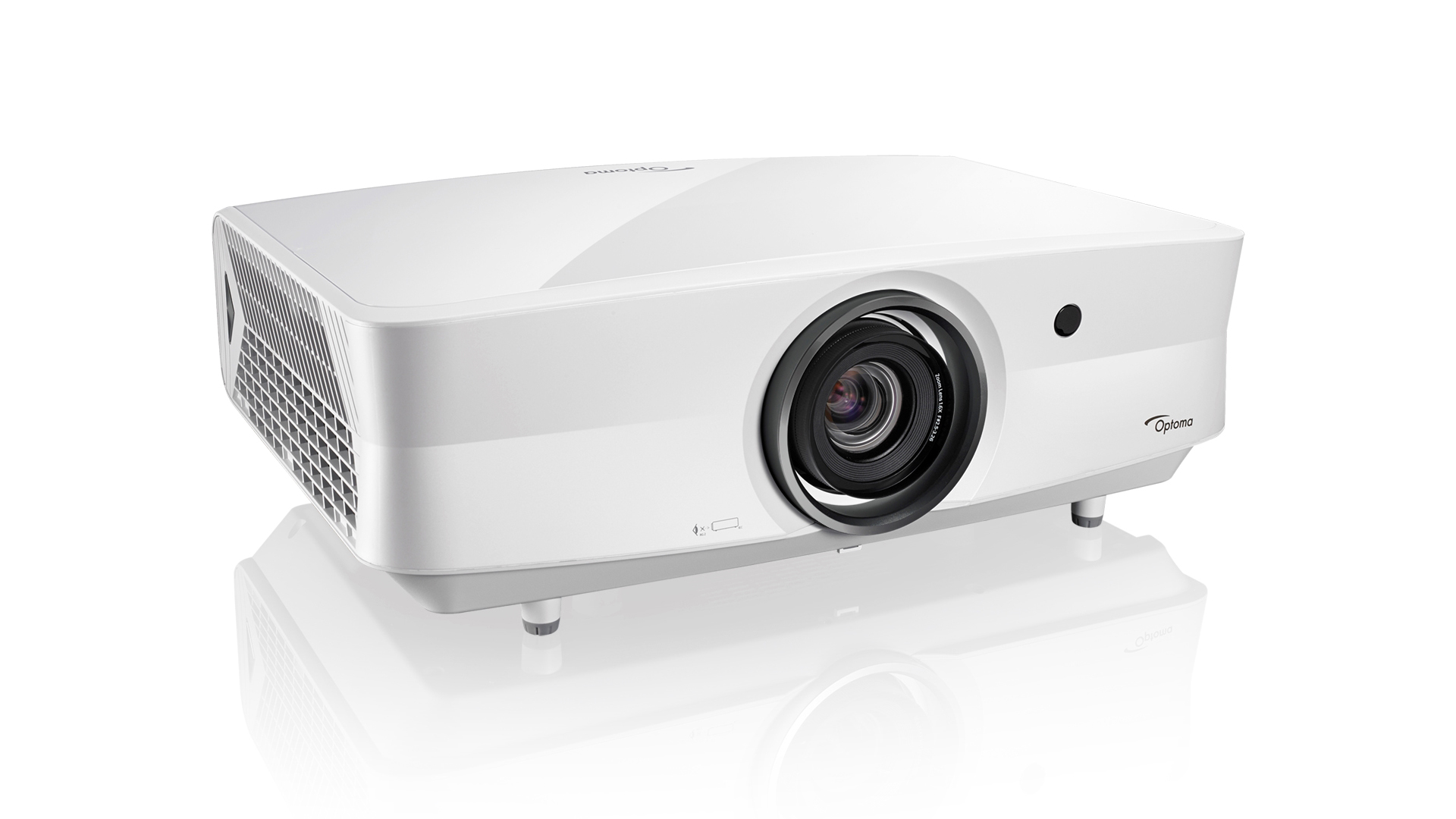
Inputs HDMI 2.0, HDMI 1.4a, Audio 3.5mm
Outputs Audio 3.5mm, S/PDIF, USB-A power 1.5A
Brightness 5000 lumens
Contrast 2,000,000:1
Laser life 30,000 hours
Zoom lens 1.6x (manual)
Throw ratio 1.39:1 ~ 2.22:1
Dimensions (hwd) 171 x 498 x 331mm
Weight 9.8kg
Bigger than many budget models, it is still designed for either tabletop or ceiling-mounted use. You can rear project too and, while mounting it on an AV rack behind the seating position is possible, it does mean having to sit it fairly low. The screw-out back feet will help, as will the lens shift feature, which offers 15 per cent movement vertically.
The lens controls are accessible underneath a flap on the top surface – again, not ideal for rack positioning – and there is a full set of buttons under there too. Of course, you’ll only ever need to use those if you lose the remote control, which is back-lit, not overly complicated and has a few customisable shortcut buttons to get you straight to the most-used settings.
The UHZ65LV is a 4K HDR machine and, as with most projectors, that HDR comes in the form of HDR10 and HLG. Optoma does not include any auto iris or other frame-by-frame contrast analysis system that you’ll find in native 4K machines at the next level up.
Of the two HDMI ports on the rear, one is version 1.4 and the other 2.0. There’s also a powered USB socket that could accommodate a media streamer plugged into one of the HDMIs. A 4W speaker system is built-in too, plus optical and aux audio outputs if you’d rather connect directly to an external sound device.
Optoma rates the maximum noise level of this projector at 31dB, though it actually sounds quieter and more consistent than other projectors that are rated the same.
Features
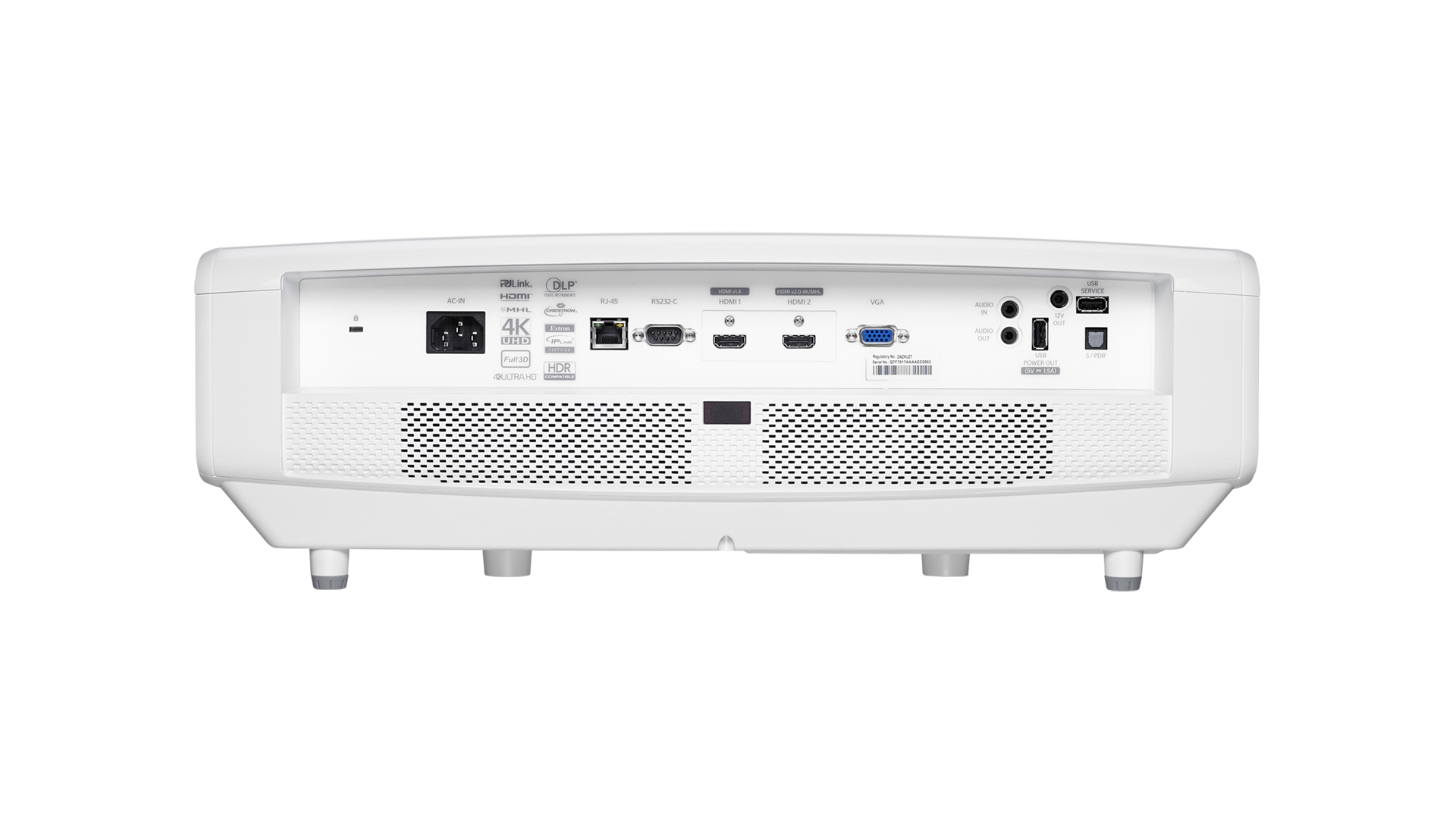
The Optoma UHZ65LV is a single-chip DLP projector with a laser phosphor light system. Light from blue laser diodes travels through a phosphor wheel to create yellow light, which is split into red and green using a colour wheel to create RGB streams required for the digital micromirror device (DMD).
That DMD is a 1.6cm panel with native resolution of 2716 x 1528, which Optoma’s pixel shifting technology uses to create a 4K on-screen image with 8.3m pixels. Focusing the light is a 1.6x zoom lens, which is manually operated and can create a picture between 27in and 302in at distances of 1.3m to 9.3m.
The end product is an image rated at 5000 ANSI lumens brightness, which Optoma claims offers a contrast ratio of 2,000,000:1. It is capable of playing 3D content, but you will need to purchase DLP Link 3D glasses separately.
The operating system is standard fare for a projector at this price. These aren’t as graphically interesting or intuitive as a TV OS and there’s no smart platform, but the options are far fewer and it’s easy enough to get around.
It is worth noting that the projector doesn’t like it when we switch between HDR modes rapidly and repeatedly during calibration. The picture becomes distorted when this happens, but this isn’t an issue in normal use and it’s easily fixed by stopping and restarting your source material again.
Picture
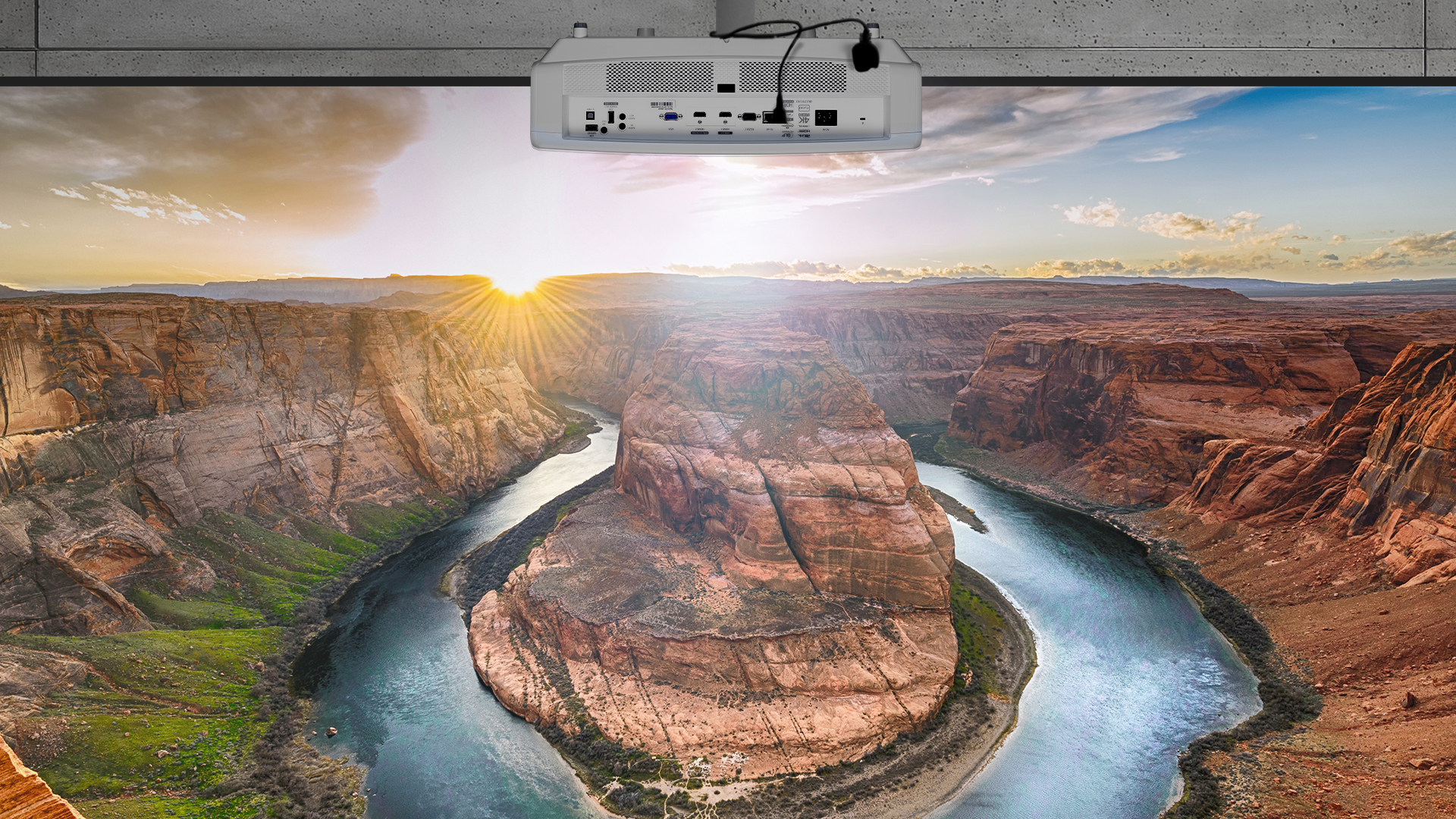
Between the bright laser source and advantages in black depth of DLP projectors, the Optoma UHZ65LV creates an image with lots of contrast. Watching Guardians Of The Galaxy: Vol.2 on 4K Blu-ray, there’s a strong, punchy HDR look to every scene, thanks to its ability to produce dark blacks and piercing whites.
There are two main picture presets to choose from and, if you want to take that TV-like HDR feel to the max, then HDR 2 is the one to use. Those after something a little softer and more cinematic should stick with HDR. It’s a tough call as to which we prefer, but HDR 2 plays to the strengths of this projector.
Watching the crash landing on Berhert, the colours are bold and the strength of tone with which the actors and scenery are reproduced is dynamic and compelling. The HDR 2 setting paints with a relatively broad brush and doesn’t project the more natural side of a picture, such as skin renditions. With the HDR preset, you get a better sense of careful shading to those tones and blend to the colours.
To find a balance that works for you, leave HDR Picture Mode on ‘Bright’ and adjust the Dynamic Black settings. Though some of that shading returns, the Optoma UHZ65LV isn’t as good in this department as we’d hoped, and certainly falls short of the current Award-winner in this category, the Epson EH-TW9400. However, the Epson doesn’t have as strong an HDR appeal, so if you prefer a big punch, the Optoma may be the better option for you.
The Optoma’s weaknesses are less obvious at SDR level. It still gets to impress with its large scale dynamics but, with less contrast metadata on offer for each scene, you don’t get the feeling that you’re missing out on too much nuance either. That extra level of shading simply isn’t there in the source. As such, the differences between this Optoma and projectors such as the Epson are far less marked.
Watching Tom Cruise’s helicopter arrival in London at the start of Edge Of Tomorrow on Blu-ray, there’s enough detail to give a three-dimensional feel to the buildings on Trafalgar Square. With SDR, we switch off the filters and start with a clean slate by opting for the Game preset. From there, it’s easy enough to build a decent performance using the Dynamic Black setting and small tweaks to Contrast, Sharpness, Brightness and Colour. The colour gamut also keeps white balance at its best, so that the grey skies and austere Georgian stonework are reproduced in the correct shades.
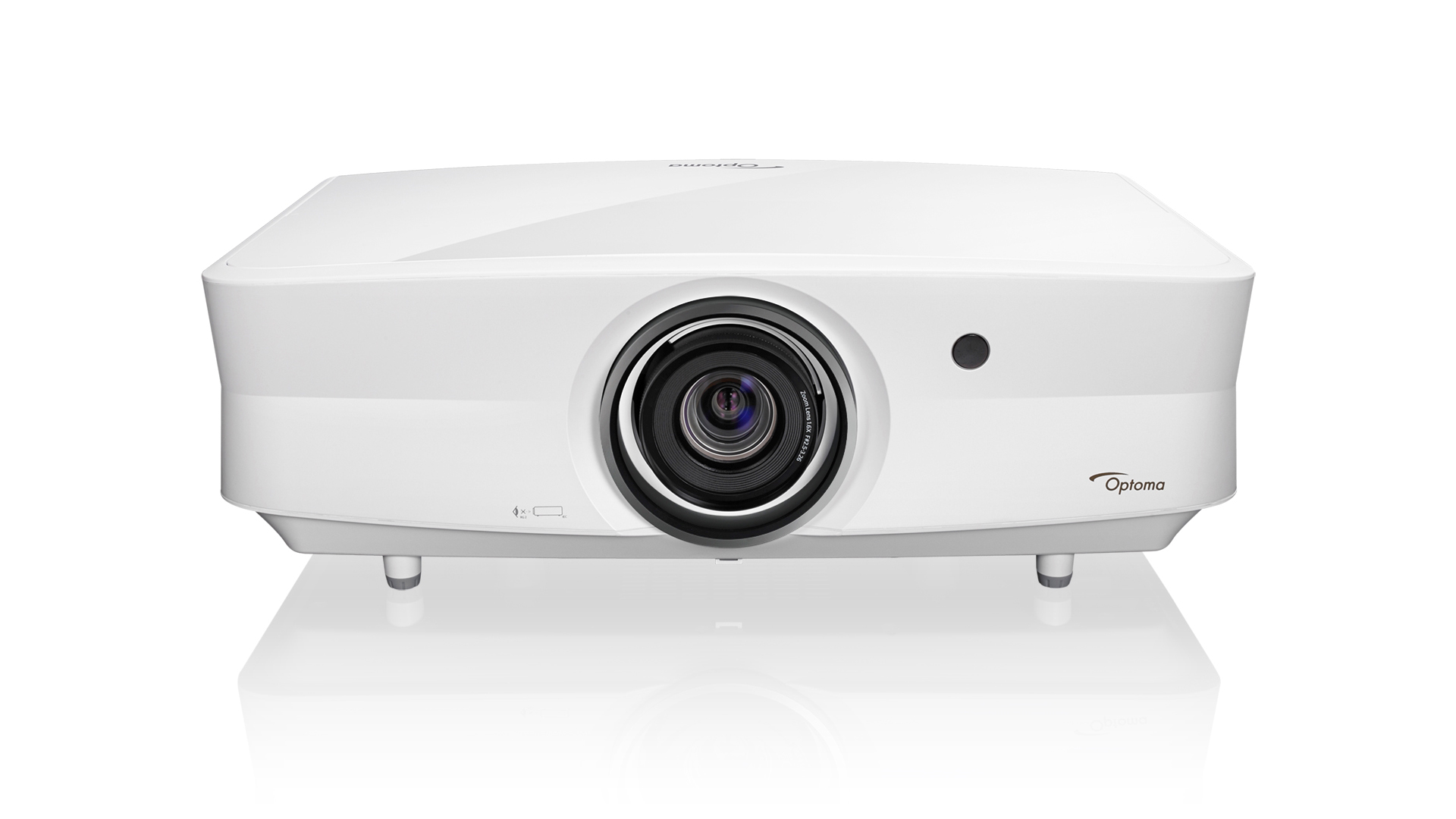
What’s also heartening is that even with dark detail, where we may expect this projector to fall down, it actually does surprisingly well. There is lots of good black depth in the nighttime Paris sequences, but there’s still a fair dose of detail in the shadows too. It’s far from the blanket black that one might predict, given this projectors generally less than subtle approach. There’s a clarity to the pockets, holsters and each item of the soldiers’ black uniforms, even if there isn’t the same level of texture that the Epson offers.
Optoma’s Pure Engine processing suite is available to try to boost contrast, detail and motion, but it doesn’t match the high standard of the rest of the systems of this device. As such, there’s little you can do about the natural judder of on-screen action. The level of judder is better than you’ll find on lower level machines, but don’t expect TV-like smoothing from the UHZ65LV.
We also have an issue with colour balance, which never feels quite right no matter what settings or modes we use. Reds tend to come off with an orange tinge, and the lower blending skills of this projector mean that the effect is most noticeable with skin tones that leave faces looking a little less than natural.
With a little stretch and a zoom, it’s possible to watch standard definition content and make it properly fill the screen, even if in 4:3. Watching season four of Battlestar Galactica on DVD, the aesthetic is very much par for the course. Its subdued tonal skills mean that the picture is a little more blotchy than that of the class-leaders, but it’s not long before we’ve put that shortcoming to one side and are settling into the character arcs of the series.
While its skew towards high contrast isn’t always a plus point, it does come in handy when watching content with ambient lighting. Switch the house lights up when using the Epson and much of that carefully controlled tonal detail is washed out. With the Optoma UHZ65LV, much of that dynamism is left intact. While we wouldn't recommend holding movie nights with this amount of light in the room, the Optoma makes a compelling case as a better choice for social occasions such as watching sport or gaming.
Verdict
The Optoma UHZ65LV represents a step forward for 4K laser projectors at this level. They’re still pricier than comparable lamp-based models, but the technology doesn’t command the large premium that it once did. That makes this projector’s strong HDR look and feel, and watchable SDR performance well worth your consideration, particularly for all-round home entertainment use.
There are still some kinks that need ironing out, though, mostly with colour complexity and balance. If Optoma can make the right tweaks for the next generation, and the engineers can layer in a little more subtlety too, then we could be looking at a five-star projector.
SCORES
- Picture 4
- Feature 4
- Build 4
MORE:
Read our guide to the best projectors
Read our Epson EH-TW9400 review
Read our Optoma UHZ65 review
What Hi-Fi?, founded in 1976, is the world's leading independent guide to buying and owning hi-fi and home entertainment products. Our comprehensive tests help you buy the very best for your money, with our advice sections giving you step-by-step information on how to get even more from your music and movies. Everything is tested by our dedicated team of in-house reviewers in our custom-built test rooms in London, Reading and Bath. Our coveted five-star rating and Awards are recognised all over the world as the ultimate seal of approval, so you can buy with absolute confidence.
-
benp The Optoma website says the UHZ65LV is 'Native 4k.' Is that true??? Your review says it isn't Native 4k. I this just Optoma giving their own definition of Native 4k??? https://www.optomausa.com/product/uhz65lvReply

